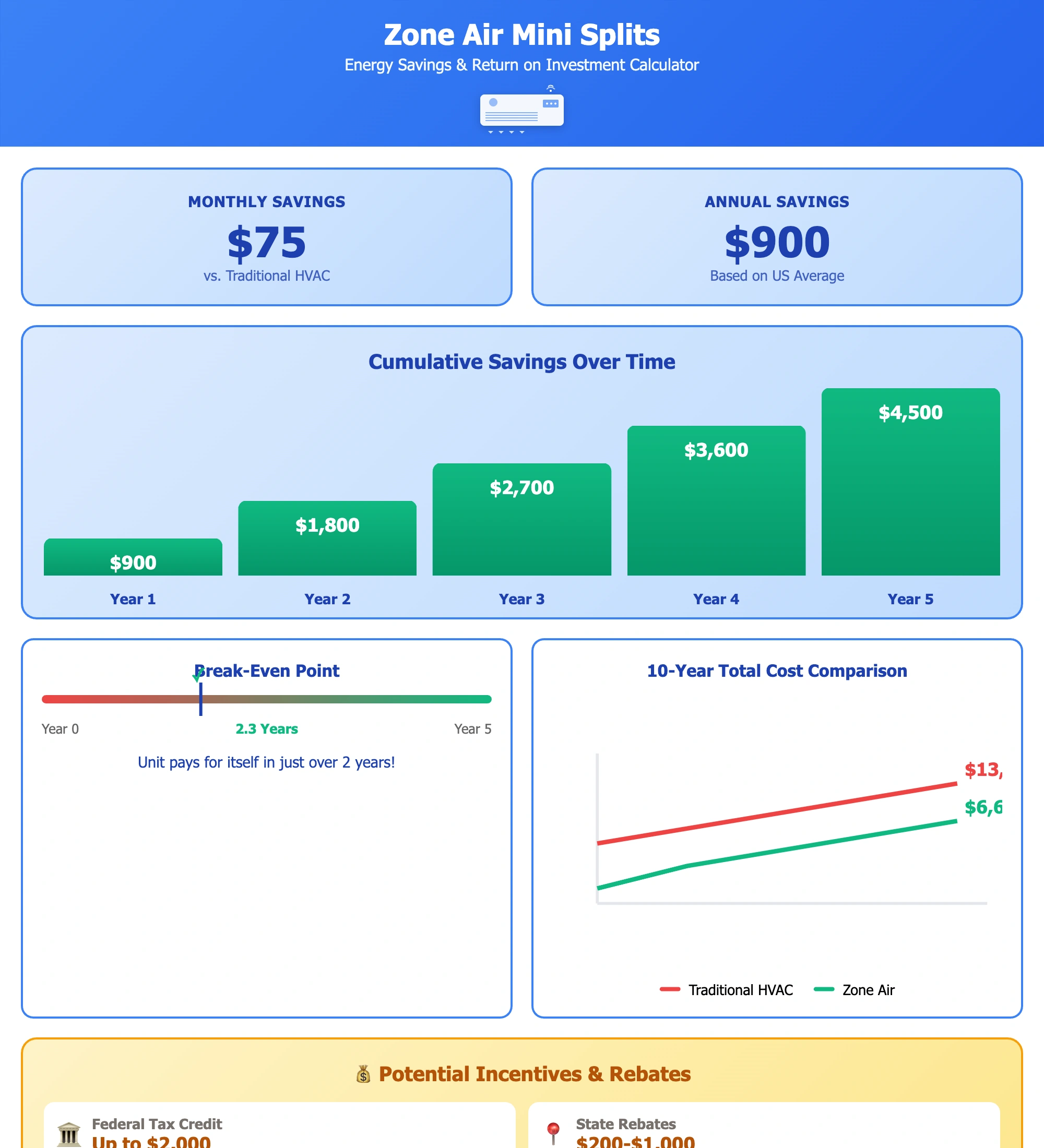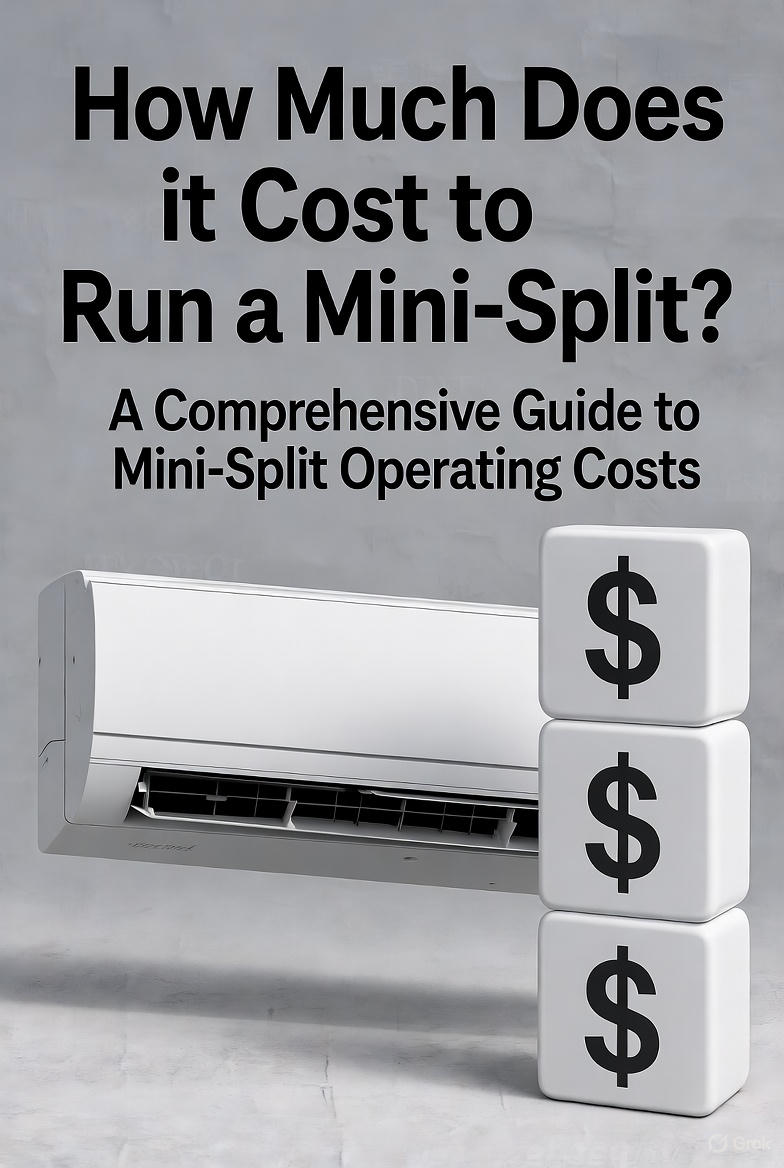Rachel Morrison kept a detailed spreadsheet for her first year with mini-splits, and the numbers told a story that still amazed her every time she reviewed them. After replacing the electric baseboard heat and window air conditioners in her 1,400-square-foot Charlotte ranch with two 12,000 BTU mini-splits, she tracked every monthly utility bill with the skepticism of someone who'd heard too many HVAC promises before.
Her old system's bills spoke for themselves: January heating peaked at $245, July cooling hit $195, and her annual electricity costs consistently exceeded $2,100. Those weren't outliers—they represented thirteen years of expensive normal. When her heating bills crossed $250 during a particularly cold February, Rachel finally admitted her 1980s baseboard heaters had become a luxury she could no longer afford.
The first winter with mini-splits changed everything. Her January 2024 bill arrived at $127—nearly half her previous heating costs. She initially assumed an unusually mild month, but February's $118 bill and March's $95 bill confirmed the pattern. Summer proved even more dramatic: July 2024 cost $88 compared to the previous year's $195, while August dropped from $178 to $82. By December, Rachel's spreadsheet showed undeniable results: her total annual electricity costs fell to $1,085, representing 48% savings and $1,015 in her pocket.
"I calculated my payback period down to the month," Rachel explained to her skeptical neighbor who was considering a similar upgrade. "My two Zone DIY Series systems cost $4,800 DIY installed. At $1,000+ annual savings, I'll break even in year five. After that, it's pure savings—potentially $15,000 over the next fifteen years. The numbers aren't marketing hype; they're my actual Duke Energy bills." Rachel's meticulous tracking revealed what many mini-split owners discover: the efficiency advantage isn't subtle—it fundamentally reshapes your relationship with climate control costs.
This guide provides the complete cost analysis Rachel used to make her decision, along with the detailed breakdowns that help you calculate exactly what mini-split ownership will cost in your specific situation. Understanding these operating costs isn't just about monthly bills—it's about recognizing that your current HVAC expenses might be unnecessarily high, and quantifying precisely how much you'll save.
💰 Interactive Savings Tools: Calculate your exact savings with our Whole Home Savings Calculator and Energy Savings & ROI Chart.

Average Monthly Operating Costs
By System Size (8 hours/day, $0.14/kWh):
9,000 BTU (18 SEER2):
- Summer cooling: $20-$30/month
- Winter heating: $35-$50/month
12,000 BTU (20 SEER2):
- Summer cooling: $25-$40/month
- Winter heating: $45-$65/month
18,000 BTU (22 SEER2):
- Summer cooling: $35-$55/month
- Winter heating: $60-$90/month
24,000 BTU (22 SEER2):
- Summer cooling: $50-$75/month
- Winter heating: $85-$125/month
Cost Calculation Formula
For Cooling: (BTU ÷ SEER2 ÷ 1000) × Hours per Day × Days per Month × Electricity Rate
Example (12K BTU, 24 SEER2, 8 hrs/day, $0.14/kWh): (12,000 ÷ 24 ÷ 1,000) × 8 × 30 × $0.14 = $16.80/month
For Heating: (BTU ÷ HSPF2 ÷ 1,000) × Hours per Day × Days per Month × Electricity Rate
Example (12K BTU, 10 HSPF2, 8 hrs/day, $0.14/kWh): (12,000 ÷ 10 ÷ 1,000) × 8 × 30 × $0.14 = $40.32/month
Efficiency Impact on Costs
12K BTU Unit Running 8 Hours/Day:
14 SEER2 System:
- Daily kWh: 6.86
- Monthly cost: $28.80
- Annual cost: $345
20 SEER2 System:
- Daily kWh: 4.80
- Monthly cost: $20.16
- Annual cost: $242
24 SEER2 System (Zone):
- Daily kWh: 4.00
- Monthly cost: $16.80
- Annual cost: $202
Annual Savings with High Efficiency:
- 24 SEER2 vs 14 SEER2: $143/year
- Over 15 years: $2,145 savings
Usage Pattern Impact
Same 12K BTU System, Different Usage:
Light Use (4 hours/day):
- Summer: $15/month
- Winter: $25/month
- Annual: $240
Moderate Use (8 hours/day):
- Summer: $30/month
- Winter: $50/month
- Annual: $480
Heavy Use (16 hours/day):
- Summer: $60/month
- Winter: $100/month
- Annual: $960
24/7 Operation:
- Summer: $90/month
- Winter: $150/month
- Annual: $1,440
Regional Electricity Rate Impact
12K BTU, 24 SEER2, 8 hrs/day cooling:
Low Rates ($0.10/kWh - Louisiana):
- Monthly: $12
- Annual: $144
Average Rates ($0.14/kWh - National):
- Monthly: $17
- Annual: $204
High Rates ($0.20/kWh - California):
- Monthly: $24
- Annual: $288
Very High Rates ($0.30/kWh - Hawaii):
- Monthly: $36
- Annual: $432
High-efficiency systems matter more in expensive electricity markets.
Heating vs Cooling Costs
Why Heating Costs More:
Heat pumps are less efficient in heating mode:
- Cooling: 200-400% efficiency (SEER2 20-24)
- Heating: 250-350% efficiency (HSPF2 9-12)
Additionally:
- Heating runs more hours per day
- Greater temperature differential
- Outdoor unit works harder in cold
Monthly Cost Comparison (12K BTU):
- Summer cooling: $25-$35
- Winter heating: $45-$65
- Heating costs 60-80% more
Multi-Zone Operating Costs
Example: 3-Zone Home
- Zone 1: 12K BTU (living room) - 8 hrs/day
- Zone 2: 9K BTU (bedroom) - 10 hrs/day
- Zone 3: 9K BTU (office) - 6 hrs/day
Monthly Cooling Cost:
- Zone 1: $30
- Zone 2: $25
- Zone 3: $18
- Total: $73/month
Key Advantage: You're only cooling rooms when needed. Central air would cool entire home constantly, costing $120-$180/month.
Savings: $47-$107/month = $564-$1,284/year
Cost Comparison: Mini-Split vs Alternatives
Cooling 500 sq ft Room (Summer Month):
Window AC (8,000 BTU, 10 EER):
- Energy use: 232 kWh
- Cost: $32/month
Portable AC (12,000 BTU, 8 EER):
- Energy use: 360 kWh
- Cost: $50/month
Mini-Split (12K BTU, 24 SEER2):
- Energy use: 100 kWh
- Cost: $14/month
Annual Savings vs Window AC: $216 Annual Savings vs Portable AC: $432
Cost Reduction Strategies
1. Use ECO Mode Reduces capacity when approaching set temperature.
- Savings: 10-20%
2. Programmable Schedule Reduce temperature when away/sleeping.
- Savings: 15-25%
3. Proper Maintenance Clean filters monthly, annual service.
- Savings: 5-15%
4. Optimal Temperature Settings
- Summer: 78°F vs 72°F saves 18%
- Winter: 68°F vs 72°F saves 12%
5. Ceiling Fans Circulate air, feel cooler without lowering temp.
- Savings: 5-10%
6. Insulation Improvements Reduce heat gain/loss.
- Savings: 20-40%
Combined Savings Potential: 40-60% reduction
Real-World Cost Examples
Case 1: Phoenix, AZ (Hot Climate)
- System: 18K BTU, 22 SEER2
- Use: 12 hours/day cooling (May-Oct)
- Rate: $0.13/kWh
- Monthly (summer): $62
- Annual: $450
Case 2: Minneapolis, MN (Cold Climate)
- System: 12K BTU, 24 SEER2, 10 HSPF2
- Use: 10 hours/day heating (Nov-Mar)
- Rate: $0.14/kWh
- Monthly (winter): $58
- Annual (heating only): $290
- Plus cooling: $120
- Total annual: $410
Case 3: Portland, OR (Moderate Climate)
- System: 12K BTU, 24 SEER2
- Use: 6 hours/day year-round
- Rate: $0.11/kWh
- Monthly average: $22
- Annual: $264
Standby Power Consumption
When not actively cooling/heating, mini-splits still draw power:
Standby Mode:
- Indoor unit: 3-10 watts
- Cost: $0.30-$1.00/month
- Annual: $3.60-$12.00
To Minimize:
- Use power switch to fully off when not needed for weeks
- Modern units have very low standby draw
Peak vs Off-Peak Rates
If your utility offers time-of-use rates:
Standard Rates:
- Summer day cooling: $0.25/kWh
- Night cooling: $0.12/kWh
Strategy:
- Pre-cool during off-peak hours
- Use ECO mode during peak
- Potential savings: 20-30%
Seasonal Cost Variation
Typical Annual Pattern (Moderate Climate):
- Spring (Mar-May): $15-$25/month
- Summer (Jun-Aug): $40-$60/month
- Fall (Sep-Nov): $20-$30/month
- Winter (Dec-Feb): $50-$75/month
Annual Average: $35/month = $420/year
Hidden Costs to Consider
Electricity:
- Main operating cost
- Variable based on use
Maintenance:
- DIY filter cleaning: Free
- Professional service: $100-$150/year
Repairs (if needed):
- Average over lifespan: $50-$100/year
Total Annual Operating Cost:
- Electricity: $200-$600
- Maintenance: $100-$150
- Average: $300-$750/year
ROI Calculation Example
Scenario: Replacing Electric Baseboard Heat
Old System Costs:
- Annual electricity: $1,800
- Maintenance: $0
- Total: $1,800/year
New Mini-Split Costs:
- Equipment + install: $2,500 (DIY)
- Annual electricity: $600
- Annual maintenance: $100
- Operating: $700/year
Annual Savings: $1,100 Payback Period: 2.3 years 15-Year Savings: $14,000
Bottom Line Operating Costs
For Average Homeowner:
- Monthly: $25-$50 (moderate use)
- Annual: $300-$600
- Per sq ft cooled: $0.50-$1.00/year
Compared to:
- Central air: $600-$1,200/year
- Window units: $400-$800/year
- Electric heat: $1,200-$2,400/year
Mini-splits typically cost 30-50% less to operate than alternatives.
Frequently Asked Questions
How much does it cost to run a mini split per month?
Running a mini split costs $25-75/month depending on usage and system size. A 12K BTU unit running 8 hours daily costs $30-45/month for cooling or $50-70/month for heating. Year-round use (cooling + heating) averages $40-60/month. This is 30-50% less than central air or electric baseboard heat for the same space.
Are mini splits expensive to run?
No, mini splits are among the cheapest HVAC systems to operate. A 12K BTU mini split with 24 SEER2 efficiency costs $300-600/year for typical use, compared to $600-1,200/year for central air or $1,200-2,400/year for electric baseboard heat. High efficiency (20+ SEER2) and zone control make them very economical.
How much does a mini split increase your electric bill?
A mini split adds $25-75/month ($300-900/year) to your electric bill depending on usage. However, if replacing electric heat, window AC units, or central air, your total bill typically DECREASES by 30-50%. The key is mini splits replace less efficient systems, resulting in net savings for most homeowners.
Do mini splits use a lot of electricity?
No, mini splits use 30-50% LESS electricity than traditional systems. A 12K BTU mini split uses 0.5-0.8 kWh per hour of operation (24 SEER2), compared to 1.0-1.5 kWh for central air or 1.5-3.0 kWh for electric baseboard heat. Inverter technology and high SEER ratings minimize electricity consumption.
What is the cheapest way to run a mini split?
To minimize costs: (1) Set temperature to 78°F cooling / 68°F heating, (2) Use zone control - only condition occupied rooms, (3) Clean filters monthly, (4) Use sleep/eco modes, (5) Raise/lower temps when away, (6) Ensure proper insulation, (7) Choose 20+ SEER2 systems. These strategies can reduce costs by 30-40%.
How much does it cost to run a mini split 24/7?
Running a 12K BTU mini split 24/7 costs approximately $60-110/month depending on whether you're heating or cooling. Annual cost: $720-1,320. However, continuous operation at low fan speeds (inverter mode) is often more efficient than on/off cycling. Most homes don't need 24/7 operation except in extreme climates.
Is it cheaper to run a mini split or central air?
Mini splits cost 30-40% less to run than central air for the same cooling capacity. A 12K BTU mini split costs $30-45/month vs $50-70/month for equivalent central air. Savings come from: higher SEER ratings (24 vs 16), no duct losses (20-30% waste), zone control, and inverter technology. Annual savings: $200-400 per zone.
About the Author: Scott Skidmore is a Senior HVAC Engineer at Zone Air with over 12 years of experience in energy efficiency analysis and operating cost optimization. He's helped thousands of homeowners calculate accurate operating costs and maximize savings through proper system selection and usage strategies. Scott specializes in long-term cost analysis, efficiency comparisons, and translating kWh consumption into real dollar savings. His expertise helps customers make data-driven decisions that minimize lifetime operating costs while maximizing comfort.
Related Articles:


